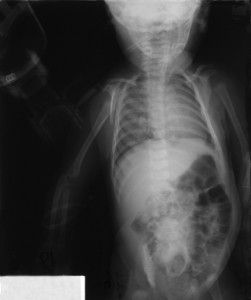Introduction
Pneumonia is an infection of the lung tissue and can either affect an entire lobe (lobar pneumonia, thanks to www.mevis.fraunhofer.de for this image) of the lung or a segment of it (segmental pneumonia). The clinician cannot make this distinction by examination alone, but needs confirmation by lung x-rays, where this distinctions can be readily made.
In the US about 2 million people come down with pneumonia each year and about 50,000 die from it, the 6th most common cause of all deaths (Ref. 9, p. 601). The most common cause of pneumonia in the adult are bacteria, whereas in children and infants viral infections are more common.
Common bacteria causing pneumonia
| Streptococcus pneumoniae | Chlamydia pneumoniae |
| Haemophilus influenzae | Chlamydia psittaci |
| Staphylococcus aureus | Chlamydia trachomatis |
| Moraxella catarrhalis | Legionella pneumophila |
| Common viruses causing pneumonia: | |
| respiratory syncytial virus (RSV) | parainfluenza virus |
| influenza A | influenza B |
| Rarer causes of pneumonia: | |
| Mycobacterium tuberculosis | Coccidioides immitis |
| Histoplasma capsulatum | Blastomyces dermatitidis |
| Cryptococcus neoformans | Pneumocystis carinii |
| Aspergillus fumigatus | Coxiella burnetii (Q-fever) |
| SARS coronavirus | bird flu (type A, H5N1 strain) |
However, there are certain high risk situations where more rare forms of pneumonia occur. For instance in AIDS, where the immune system is weakened from the AIDS virus, interstitial pneumonia with Pneumocystis carinii is very common.
This pathogen, which has been considered to be a protozoan parasite, has recently been shown to have DNA sequences of a fungus type. X-rays show typical interstitial infiltrates (thanks to www.medscape.com for this image) on both lungs. Bronchoscopy is indicated to obtain samples from the infected areas for culture and microscopic identification.
References:
1. The Merck Manual, 7th edition, by M. H. Beers et al., Whitehouse Station, N.J., 1999. Chapter 161.
2. TC Dixon et al. N Engl J Med 1999 Sep 9;341(11):815-826.
3. F Charatan BMJ 2000 Oct 21;321(7267):980.
4. The Merck Manual, 7th edition, by M. H. Beers et al., Whitehouse Station, N.J., 1999. Chapter 43.
5. JR Zunt and CM Marra Neurol Clinics Vol.17, No.4,1999: 675-689.
6. The Merck Manual, 7th edition, by M. H. Beers et al., Whitehouse Station, N.J., 1999. Chapter 162.
7. LE Chapman : Antivir Ther 1999; 4(4): 211-19.
8. HW Cho: Vaccine 1999 Jun 4; 17(20-21): 2569-2575.
9. DO Freedman et al. Med Clinics N. Amer. Vol.83, No 4 (July 1999): 865-883.
10. SP Fisher-Hoch et al. J Virol 2000 Aug; 74(15): 6777-6783.
11. Mandell: Principles and Practice of Infectious Diseases, 5th ed., © 2000 Churchill Livingstone, Inc.
12. Goldman: Cecil Textbook of Medicine, 21st ed., Copyright © 2000 W. B. Saunders Company
13. PE Sax: Infect DisClinics of N America Vol.15, No 2 (June 2001): 433-455.
14. Ferri: Ferri’s Clinical Advisor: Instant Diagnosis and Treatment, 2004 ed., Copyright © 2004 Mosby, Inc.
15. Rakel: Conn’s Current Therapy 2004, 56th ed., Copyright © 2004 Elsevier







